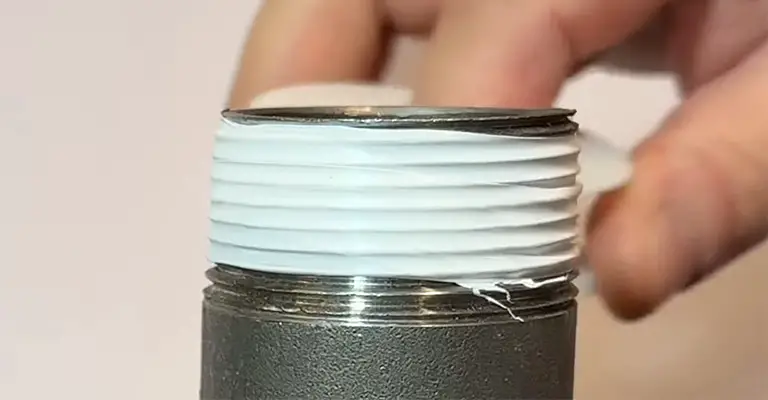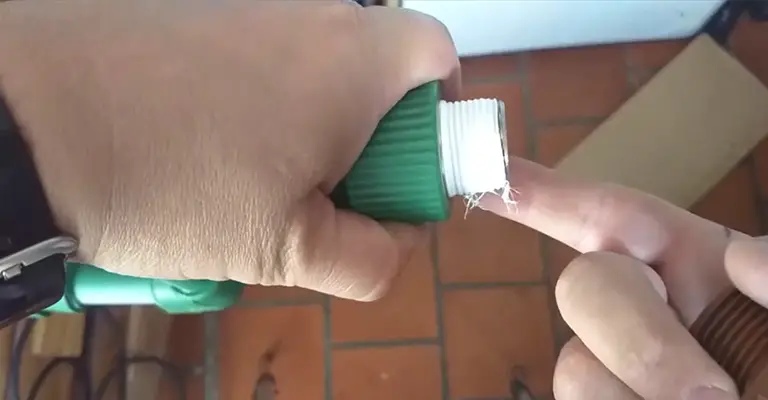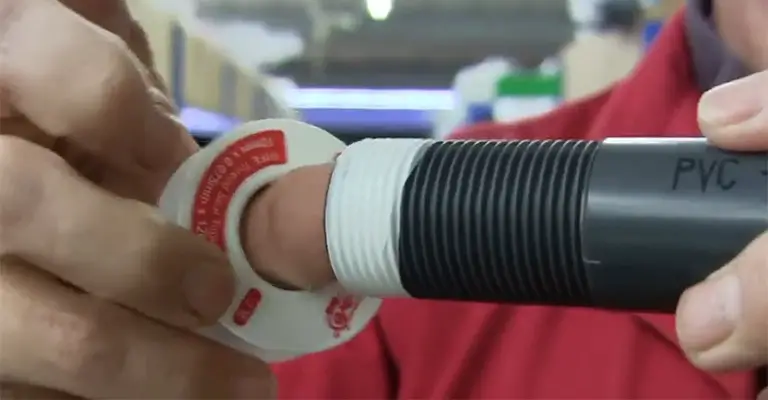When it comes to plumbing, the proper use of Teflon tape on PVC to metal connections is an essential aspect that every DIY enthusiast or homeowner should be familiar with.
Teflon tape, also known as plumber’s tape or PTFE tape, is a thin, white tape commonly used to create a watertight seal on threaded pipe connections.
While it might seem like a simple addition to your plumbing toolkit, understanding how and when to use Teflon tape correctly can make a significant difference in the success and durability of your plumbing projects.
Do I Need Teflon Tape on PVC to Metal?
Use a sealant instead. Pipe dope, Teflon paste, and Teflon tape are intended for metal pipe and fittings.
In comparison to plastic, metal to metal fitting joints are more difficult to tighten; without lubricants such as Teflon, pipe dope, etc., the surfaces tend to gall. This lubrication is not necessary for plastic fittings.
When connecting PVC (Polyvinyl Chloride) to metal pipes, it is generally not necessary to use Teflon tape.
Teflon tape is commonly used to create a leak-proof seal on threaded connections, but it is primarily used with metal-to-metal connections.
PVC pipes are typically joined using solvent cement or mechanical fittings rather than threaded connections.
For PVC-to-metal connections, the appropriate methods of joining are:
Solvent Cement
This is the most common method for joining PVC pipes. It involves applying a special solvent cement to the ends of the PVC pipe and the metal fitting.
When the two materials are joined, the solvent softens and fuses the PVC and metal, creating a strong and watertight bond.
Mechanical Fittings
There are various types of mechanical fittings designed specifically for connecting PVC to metal pipes. These fittings typically have rubber gaskets or O-rings that provide a seal between the PVC and metal surfaces.
Using Teflon tape on PVC-to-metal connections is not recommended and may not provide a secure seal. It’s essential to use the appropriate joining method for each type of pipe material to ensure a reliable and leak-free connection.
Always follow the manufacturer’s instructions and local building codes when working with plumbing systems.
Use of Teflon Tape on PVC to Metal Connections

Many plumbing systems consist of a mix of PVC pipes and metal fittings, making it crucial to understand the role of Teflon tape in such connections.
The use of Teflon tape helps prevent leaks, which can lead to water damage, mold growth, and costly repairs.
Furthermore, improper application of Teflon tape can result in compatibility issues between PVC and metal, leading to corrosion, deterioration, and potential system failures.
By delving into the proper application and considerations when using Teflon tape, homeowners and DIY enthusiasts can ensure the longevity and efficiency of their plumbing systems.
Understanding Teflon Tape
Teflon tape, also known as PTFE (Polytetrafluoroethylene) tape or plumber’s tape, is a non-sticky, thin, and flexible tape widely used in plumbing and pipefitting applications.
It is made from PTFE, a synthetic fluoropolymer known for its excellent chemical resistance, high temperature tolerance, and low friction properties. The tape is usually white in color and comes in various widths and thicknesses.
Composition and Properties of Teflon Tape
Teflon tape is made from PTFE, a fluoropolymer consisting of carbon and fluorine atoms arranged in a unique molecular structure. This configuration gives PTFE its extraordinary properties, making it an ideal material for sealing pipe connections. Some key properties of Teflon tape include:
- Non-stick: Teflon tape has a non-stick surface, which prevents adhesion to other materials. This feature allows for easy application and removal during plumbing installations or repairs.
- Chemical Resistance: PTFE is highly resistant to various chemicals, including acids, bases, solvents, and most corrosive substances commonly found in plumbing systems. This resistance ensures the longevity and effectiveness of the tape.
- Temperature Tolerance: Teflon tape can withstand a wide temperature range, making it suitable for both hot and cold water applications. It remains stable at high temperatures, preventing degradation or melting during use.
- Low Friction: PTFE has an extremely low coefficient of friction, which helps in tightening threaded connections smoothly and effectively.
Common Applications of Teflon Tape in Plumbing
Teflon tape finds widespread use in plumbing due to its sealing properties and compatibility with various pipe materials. Some common applications include:
- Threaded Pipe Connections: Teflon tape is commonly used on threaded connections to create a reliable and leak-free seal between pipe fittings, such as elbows, tees, and couplings.
- Showerheads and Faucets: When installing or replacing showerheads and faucets, applying Teflon tape on the threaded connections ensures a tight seal and prevents water leaks.
- Toilet Connections: Teflon tape is used on the threaded connections between water supply lines and toilet tanks to prevent water leakage.
- Valves and Hose Bibs: Teflon tape is applied on the threads of valves and hose bibs to create a watertight seal and prevent potential leaks.
How Teflon Tape Works as a Sealant?

Teflon tape works as a highly effective sealant primarily due to its malleable and deformable nature. When wrapped around a threaded pipe connection, the tape conforms to the threads and fills any small gaps or imperfections between them.
As a result, it creates a tight and reliable seal that prevents water or gas from escaping. Additionally, Teflon tape’s non-stick property allows for easy tightening of the threaded connection, as it reduces the friction between the threads.
This makes it easier to achieve the desired level of tightness without damaging the pipe or fittings.
Different Types of PVC Pipes and Fittings
PVC (Polyvinyl Chloride) pipes and fittings are widely used in plumbing systems due to their durability, affordability, and corrosion resistance. There are various types of PVC pipes and fittings available, including:
- Schedule 40 PVC: This is the most common type of PVC pipe used for residential and commercial plumbing applications. It is suitable for both pressurized and non-pressurized systems.
- Schedule 80 PVC: This type of PVC pipe has a thicker wall compared to Schedule 40, making it more suitable for higher-pressure applications.
- PVC DWV (Drain-Waste-Vent): DWV pipes are used for non-pressurized applications, such as drainage, waste, and vent systems in buildings.
- PVC Couplings, Elbows, Tees, and Adapters: These fittings allow for various configurations and connections in plumbing systems.
Common Metals Used in Plumbing Connections
Metal pipes and fittings are often used in combination with PVC pipes in plumbing installations. Some common metals used in PVC to metal connections include:
- Brass: Brass fittings are popular for their excellent corrosion resistance and durability. They are commonly used in water supply lines and for various other applications.
- Stainless Steel: Stainless steel is highly resistant to corrosion and is often used in outdoor or harsh environments where water quality is a concern.
- Galvanized Steel: Galvanized steel pipes are coated with a layer of zinc, providing some level of corrosion resistance. However, they are not recommended for potable water systems due to the potential release of harmful substances.
- Copper: Copper pipes and fittings are widely used in plumbing for their superior conductivity and resistance to corrosion.
Challenges and Potential Issues with PVC to Metal Connections
PVC to metal connections present some unique challenges and potential issues:
- Dissimilar Expansion Rates: PVC and metal have different expansion and contraction rates when exposed to temperature changes. This difference can lead to stress on the connection points, potentially causing leaks over time.
- Thread Compatibility: Ensuring that the threads of the PVC and metal components are compatible is essential for creating a proper seal. Mismatched threads may result in leaks.
- Chemical Compatibility: Some chemicals, present in the water supply or plumbing systems, may react with certain metals or PVC, leading to corrosion or degradation.
- Electrolysis: When metal and PVC are in direct contact, electrolysis can occur due to electrical currents in the plumbing system. This can cause corrosion and damage to the pipes and fittings.
Purpose of Teflon Tape in PVC to Metal Connections
One of the primary purposes of Teflon tape in PVC to metal connections is to create a watertight seal.
The tape fills any gaps or imperfections between the threads of the pipes and fittings, preventing water or gas from leaking out of the connection points.
This helps avoid water damage to surrounding areas and ensures the efficient functioning of the plumbing system.
Addressing Compatibility Issues Between PVC and Metal
Teflon tape acts as a barrier between the dissimilar materials of PVC and metal, reducing the risk of chemical reactions or corrosion caused by contact.
By providing a protective layer, the tape helps maintain the integrity and longevity of the connection.
Reducing the Risk of Corrosion and Rust
Corrosion is a common issue in metal plumbing systems, and Teflon tape can help mitigate this problem when used in PVC to metal connections.
By preventing water from entering the threaded areas, the tape minimizes the chances of rust formation, enhancing the overall durability of the connection.
Step-by-Step Guide on Applying Teflon Tape on PVC to Metal Connections
Preparing the Surfaces for the Application:
- Ensure the threads of both the PVC and metal components are clean and free from debris or old tape residues.
- Use a clean cloth or brush to remove any dirt, grease, or moisture from the threads.
- For better adhesion, you can lightly sand the threads using fine-grit sandpaper.
Choosing the Right Type of Teflon Tape for the Connection:
- Select the appropriate width and thickness of Teflon tape. Thicker tapes are generally used for larger pipe connections with higher pressure ratings.
- Use a Teflon tape labeled as “white” for general plumbing applications.
- For specialized connections, such as those involving gas lines, look for Teflon tape labeled as “yellow” or specifically designed for gas use.
Techniques for Applying Teflon Tape Effectively:
- Hold the end of the Teflon tape against the starting point of the male threads (the outer threads).
- Wrap the tape around the threads in the same direction as the threads. Generally, clockwise wrapping is used.
- Overlap the tape by about 1/4 to 1/2 of its width with each wrap, ensuring complete coverage.
- Use gentle pressure as you wrap to avoid stretching or tearing the tape.
- Continue wrapping until you cover all the threads evenly, leaving the last thread exposed for a clean connection.
Tips for Avoiding Common Mistakes:
- Do not apply too much Teflon tape, as excessive tape can cause the threads to bind and create leaks.
- Avoid wrapping the tape in the opposite direction of the threads, as this may cause the tape to unravel during tightening.
- Ensure the Teflon tape is applied only to the male threads and not the female threads of the connection.
- Check for any wrinkles or gaps in the tape as you wrap, and correct them to maintain a consistent seal.
- Use a sharp utility knife to trim any excess tape from the end of the connection for a neat finish.
Alternatives to Teflon Tape for PVC to Metal Connections
Pipe Dope and Thread Sealants: Pipe dope and thread sealants are liquid or paste-like substances applied directly to the threads.
They fill gaps and create a seal when the threads are tightened. They offer similar sealing properties to Teflon tape and are commonly used in high-pressure or industrial applications.
O-rings and Gaskets: O-rings and gaskets are rubber or silicone seals placed between the PVC and metal components. They provide a reliable and long-lasting seal by compressing when the connection is tightened.
Using Transition Fittings: Transition fittings are specially designed connectors that provide a smooth transition between PVC and metal pipes.
They eliminate the need for Teflon tape or other sealants, ensuring a secure and leak-free connection between the two materials.
Before choosing an alternative, it’s essential to consider the specific application, pressure ratings, and compatibility with the materials involved.
Each option has its advantages, and consulting with a professional plumber can help in making the right choice for your plumbing project.
Factors to Consider When Using Teflon Tape
Temperature and Pressure Ratings: Before using Teflon tape on PVC to metal connections, it is essential to check the temperature and pressure ratings of the tape.
Different types of Teflon tape have varying temperature and pressure tolerances. Ensure that the chosen tape can withstand the specific conditions of your plumbing system to avoid tape failure and potential leaks.
Compatibility with Different Pipe Materials: Confirm that the Teflon tape is compatible with both the PVC and metal materials used in your plumbing connections.
Some tapes may not be suitable for certain metals or PVC formulations, leading to chemical reactions or degradation over time. Always choose a tape that is approved for use with the specific materials in your plumbing system.
Maintenance and Replacement Considerations: Teflon tape can wear out or become damaged over time, especially in high-pressure systems.
Regularly inspect the connections for signs of wear, fraying, or leaks. Plan for periodic maintenance, and when necessary, replace the Teflon tape to ensure the continued integrity of the connections.
Safety Precautions and Best Practices
Proper Ventilation During Application: When applying Teflon tape, ensure there is proper ventilation in the working area.
Although Teflon tape itself is generally safe, the application process can create airborne particles that might cause respiratory irritation. Open windows or use fans to improve air circulation during application.
Handling and Storage of Teflon Tape: Store Teflon tape in a cool, dry place away from direct sunlight and heat sources. Avoid exposure to extreme temperatures, as this can affect the tape’s properties and performance.
When handling the tape, refrain from tearing it with your teeth or using sharp tools, as this can damage the tape and potentially cause injuries.
Safety Gear and Precautions When Working with PVC and Metal: When working with PVC and metal plumbing components, consider the following safety precautions:
- Wear appropriate personal protective equipment (PPE), such as gloves and safety glasses, to protect yourself from potential injury.
- Be cautious when working with metal pipes and fittings to avoid sharp edges or burrs that can cause cuts or abrasions.
- Use proper tools for cutting and joining PVC and metal pipes to avoid accidents and ensure precise connections.
- Shut off the water supply and release pressure from the plumbing system before making any changes or repairs to avoid sudden bursts of water or gas.
- If unsure about the project’s complexity or encountering unfamiliar plumbing challenges, consider seeking assistance from a licensed plumber to ensure safe and accurate installations or repairs.
By taking these safety precautions and following best practices, you can minimize risks, ensure the effectiveness of Teflon tape, and maintain a safe working environment during your plumbing projects.
Troubleshooting PVC to Metal Connections with Teflon Tape
Identifying Common Issues and Leaks:
- Visual Inspection: Conduct a visual inspection of the PVC to metal connections for signs of water or gas leaks. Look for any wet spots, drips, or discoloration around the connection points.
- Audible Indications: Listen for hissing sounds, which could suggest a gas leak, or dripping sounds, indicating a water leak.
- Feel for Moisture: Run your hand along the connections to detect any moisture or dampness.
- Bubble Test: For gas connections, apply a soap solution to the joints and observe for bubbles forming, indicating a leak.
- Pressure Testing: In some cases, performing a pressure test on the system can help identify leaks or weaknesses in the connections.
Repairing and Reapplying Teflon Tape as Needed:
If you identify any leaks or issues with the PVC to metal connections, follow these steps for repair:
- Turn Off the Water/Gas Supply: Shut off the water supply or gas flow to the affected connection before starting any repair work.
- Remove the Old Teflon Tape: Carefully unwrap and remove the old Teflon tape from the threads.
- Clean and Inspect: Clean the threads of both the PVC and metal components, inspecting them for damage or wear. Replace damaged parts if necessary.
- Apply New Teflon Tape: Reapply fresh Teflon tape to the male threads, following the techniques mentioned in the Step-by-Step Guide (Section V).
- Reassemble and Tighten: Reassemble the PVC to metal connection and use appropriate tools to tighten the joint securely without over-tightening.
- Test for Leaks: Turn on the water supply or gas flow and check for any new leaks. Perform a bubble test or listen for any hissing or dripping sounds.
- Monitor and Maintain: Monitor the repaired connection over time and perform regular maintenance to ensure its continued integrity.
Conclusion
Teflon tape plays a crucial role in ensuring secure and leak-free connections between PVC and metal components in plumbing systems.
Its ability to prevent leaks, address compatibility concerns, and reduce the risk of corrosion makes it an essential tool for plumbers and DIY enthusiasts alike.
As you venture into plumbing projects involving PVC to metal connections, remember to choose the appropriate Teflon tape for the specific application, consider compatibility and temperature/pressure ratings, and apply the tape correctly using the recommended techniques.
Regular inspection, maintenance, and timely repairs will help maintain the efficiency and safety of your plumbing system.
While this guide provides valuable information, plumbing can be complex and challenging. When dealing with unfamiliar situations or complex plumbing issues, do not hesitate to seek the assistance of a licensed plumber.
Professional expertise ensures that your plumbing system is correctly installed, maintained, and repaired, reducing the risk of potential hazards and maximizing its performance. Your safety and the integrity of your plumbing system should always be a top priority.







